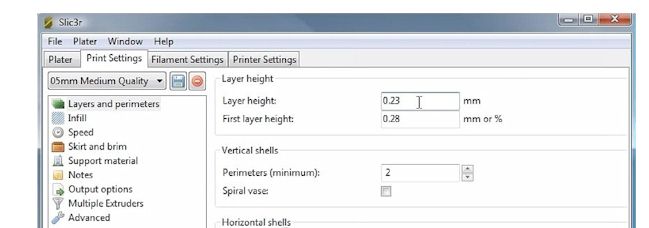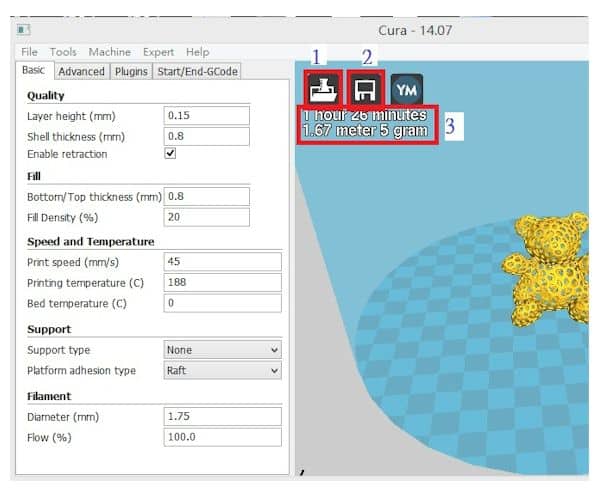A critical part of your 3D printing experience is the slicer software. It’s the software where you get all your 3D printing settings and load up the design files. There is something called G-code, which essentially turns the design file to be readable by your 3D printer.
Among many different slicer programs, two famous names always have been in clash back and forth. It’s the classic battle between Slic3r vs. CURA. Here, I will go through a bit of comparison between these programs.
By the end of this, you will know which program suits your needs better. So, if you are confused about choosing one or the other, then this is the place to be. Let’s not waste any more time and jump right into it.
What Is Slic3r?
Now, this is an excellent slicer software for turning your STL design files into G-code. It’s open-source software for working on 3D model printing. There are lots of features and advantages you get from using the slic3r software for your 3D printing. Let’s go through them one by one.
Compatibility
The first thing to love about this Slic3r software is the broad compatibility this offers. You can use this software with a lot of different 3D printer brands out there. To name a few, Makerbot, Rostock, Ultimaker, Mach 3, TAZ, MakerGear, and so forth.
Also, it’s not just about the printers. You also get good compatibility for reading files. The software can easily read STL, AMF, and OBJ files and provide you with the G-code. It also gives out SVG files which are so easy to edit using any coder.
Aside from that, it’s also compatible with most operating systems. Whether you are using Linux, Windows, or macOS, you don’t need to worry about that. Since it’s open-source software, you download it and start using it.
Related: CURA jerk settings
Versatile in options
Whether you are a beginner or an advanced user, you can use the Slic3r software for both purposes. The software comes with a beginner mode which makes things much simpler for you. It removes a lot of advanced options, so you don’t have to think about them.
As for advanced users, you can use a lot of advanced features if you want. It provides an excellent level of control for advanced users as well. So, you won’t have to miss out on any advanced functionalities either.
Works fast
Have an old and slow computer? Don’t worry about it at all. This software is pretty light and works very fast regardless of your device’s specs. It doesn’t put too much pressure on the CPU or any other component of your computer. As a result, you may not see any issues with the performance of the software or your computer.

It’s free and full of features.
Slic3r is free software that anyone can use whenever they want. And the best part is that you get a lot of functionalities and features even though it’s free software. That’s something you can always admire about this one.
You get features like micro layering, automatic support creation, drag and drop object placement, and a lot more.
As you can see, there are so many things to like about this slicing software. Even though it has a beginner mode, it’s not the most beginner-friendly software out there. With a ton of options, it’s easy to get lost within those features. Still, if you can make it work, this is excellent slicer software.
About CURA
Now, let’s dive deep into another renowned slicer software CURA. This is one of the top software when it comes to slicer software for 3D printing. It essentially comes from the brand Ultimaker. Many professionals use this software for their 3D printing purposes, making it a lot more reliable than a slicer software. Let’s quickly check out the features and see why professionals rely on this one.
Compatibility
Here’s the thing with CURA, you will never have to worry about compatibility. Even though it comes from Ultimaker, you can use this software for almost any 3D printer brand. It even comes with profiles for different 3D printer brands out there.
Coming to the aspect of file compatibility, well, it outweighs almost any other software there. You can work with STL, X3D, OBJ, 3MF files along with JPG, BMP, GIF, and even PNG files. There is no limitation to working with these files on CURA whatsoever.
And as you can already guess, it’s compatible with all operating systems as well. It’s open-source software, after all.
Ease of usage
The Cura software is super simple to use, even for a beginner out there. The thing that makes it easy to use is the premade profiles options. Suppose you don’t know anything about the slicer settings. You simply choose a profile based on your printer. That’s enough to get some 3D prints without causing any issue at all.
Need to work on advanced stuff? Well, hop into the custom options and get complete control over your slicer software to edit those advanced settings.
Added plugins
A great advantage you get with CURA software is the integration of the plugin. You can add plugins to the software to make your 3D printing experience more fulfilling and accessible. Some plugins make the whole printing process more accessible than you can even imagine.

Filled with features
Well, it’s free software that comes loaded with features and functions. You get everything you would need in slicer software for accessible and high-quality 3D prints. There is simply nothing missing from the software.
It gives a lot of tweaking options like density, padding, layers before you start printing. Forgot to change some G-codes? Well, you can vary your g-code while it’s printing with the CURA software. Everything works perfectly with this software.
Overall, it’s an excellent slicer software that you can use for your 3D printing purposes. As a beginner, you should stick to the premade profiles. But as you start to get the hang of it, you can move on with the advanced stuff that unlocks the software’s true potential. If you want to know more about CURA, I have got an in-depth look into that as well; you can check it out.
Related: IdeaMaker vs Cura, PrusaSlicer vs Cura Comparison and Cura vs Simplify3d Comparison
Slic3r vs. CURA
Now that we know a bit of both the software, it’s time to get into the comparison. Here, I will go through different factors that differentiate the two software. You will have to choose one of the software based on which factors affect you the most. Let’s get going with it.
Pros of CURA
Here’s a quick look at the pros of CURA –
- CURA has a marketplace for plugins that you can’t find in any other slicer software. You can add plugins to make it much more convenient and easier to use.
- You can pause your printing in the middle through the custom scripts feature. This allows you to do minor tweaks while in the middle of the printing process.
- The software is pretty intuitive, making it super easy to use—an excellent option for beginners without any questions.
- The user interface of CURA is intuitive and straightforward. It also has a stylish and sleek appeal.
- CURA comes with a powerful engine that can slice larger file sizes within moments.
- This one is compatible with a lot of different file types and printers as well.
Cons of CURA
There are a few cons of using CURA as well; let’s go through them a little.
- The G-code customizing options on CURA are limited compared to Slic3r.
- There are some things hard to find in the user interface of CURA.
- The system requirements for using CURA are pretty higher than other slicing software.
Pros of Slic3r
Now, let’s have a look at the pros of Slic3r –
- The slic3r software works a lot faster than CURA and doesn’t require a powerful device at all.
- It gives you better control over the G-code customization, which is appealing for advanced users.
- All the features and functionalities in the slic3r software are much more refined than CURA.
- The user interface of the software is much more organized, especially with the settings.
- It has got a professional-looking sleek design.
- Slic3r is compatible with a lot of different file types out there.
Cons of Slic3r
Well, there are some obvious cons to the Slic3r software –
- The software isn’t the best for beginners because of the non-intuitive user interface.
- It doesn’t have as many features as CURA.
- The engine for Slic3r isn’t as powerful as CURA.
- It’s not compatible with most of the printers.
Related: Use CURA to Create a Temperature Tower
Verdict
All in all, the decision between Slic3r vs. CURA comes down to usability. If you are a beginner and starting with 3D printing, then CURA is a great option to begin your journey. It’s comparatively more straightforward and has better compatibility than Slic3r. And you can continue with it even at advanced levels.
However, if you don’t have a powerful device and want to avoid performance issues, then Slic3r is a better pick. It works very fast and gives you great scope for G-code customization. You will need to spend a little more time learning this software compared to CURA.
In reality, both the software is impressive in performance. Both are open-source and free, so there is no harm in trying both of them. Then you can choose the one that you like using more.
Contents
